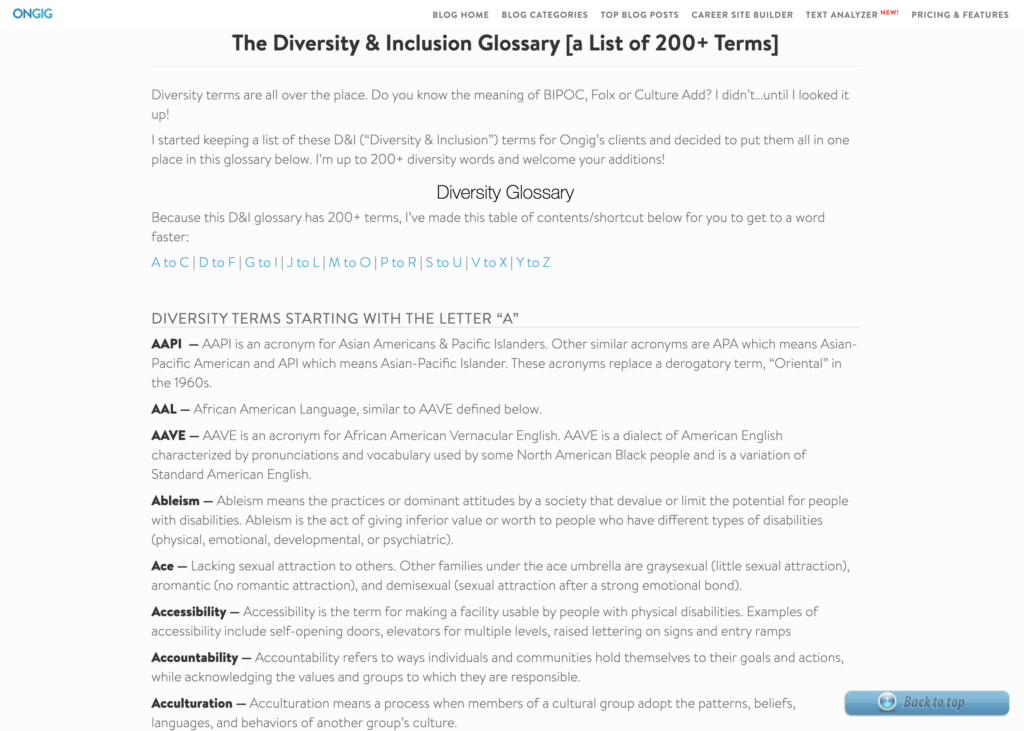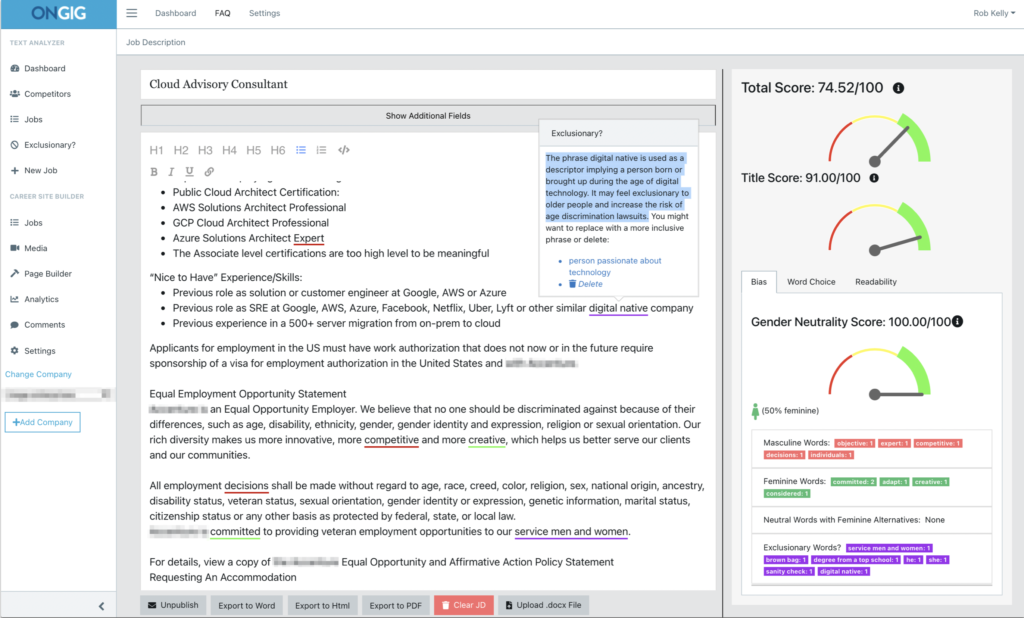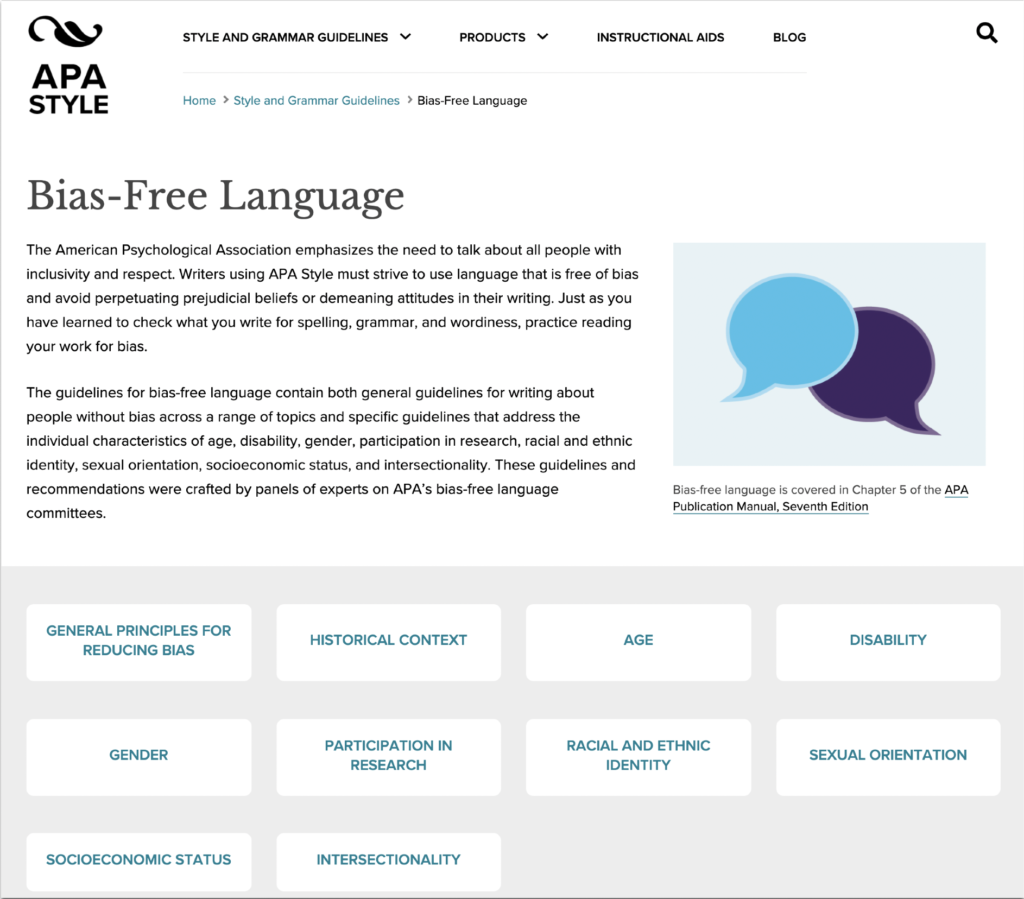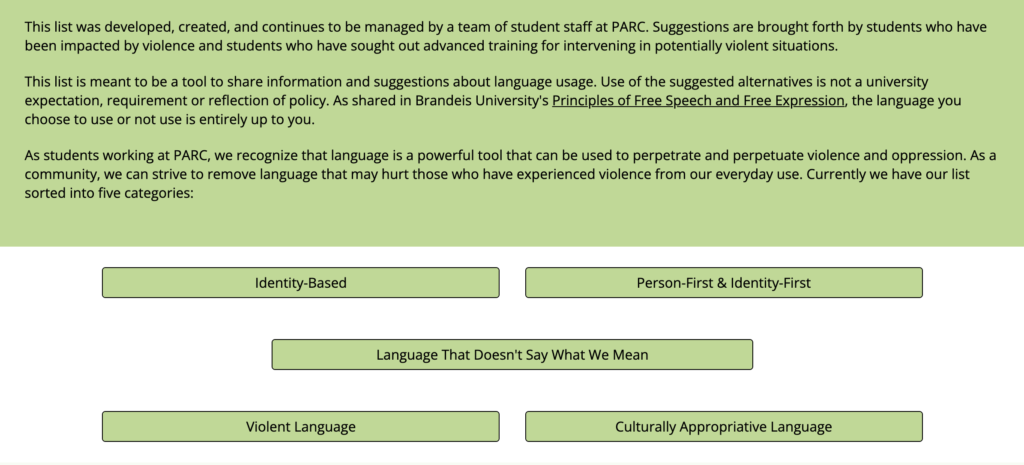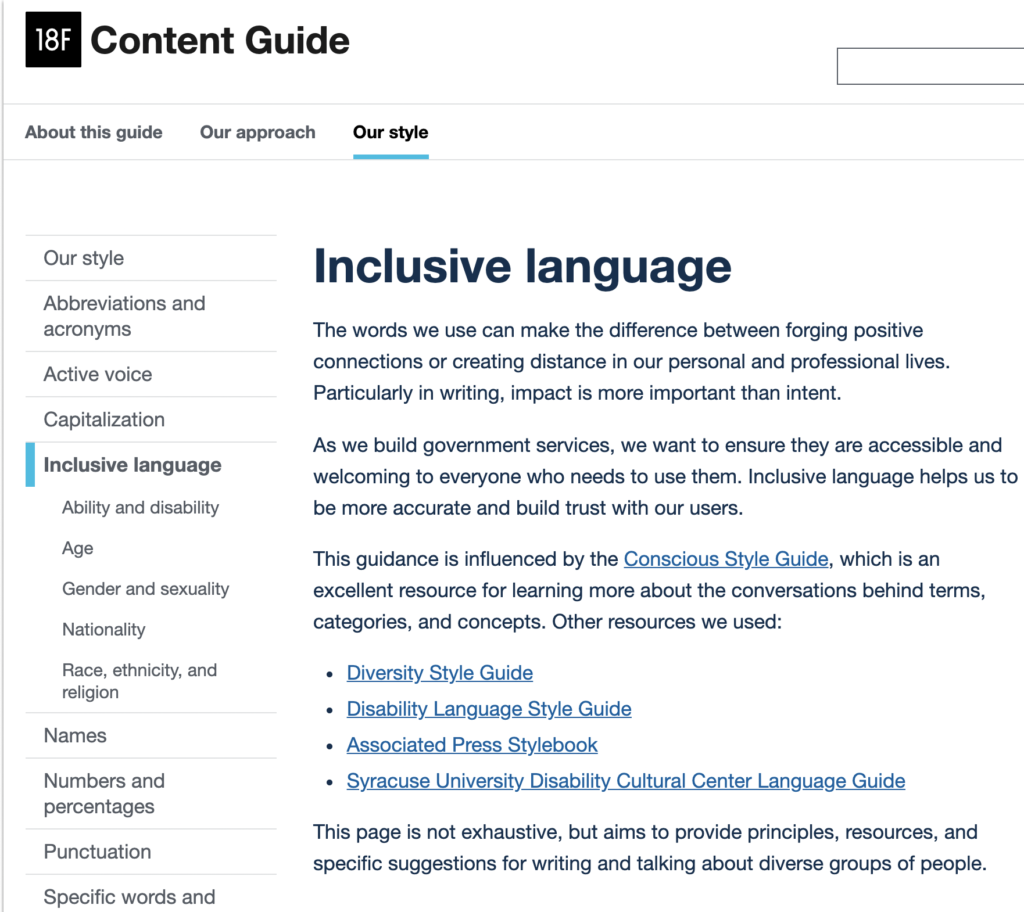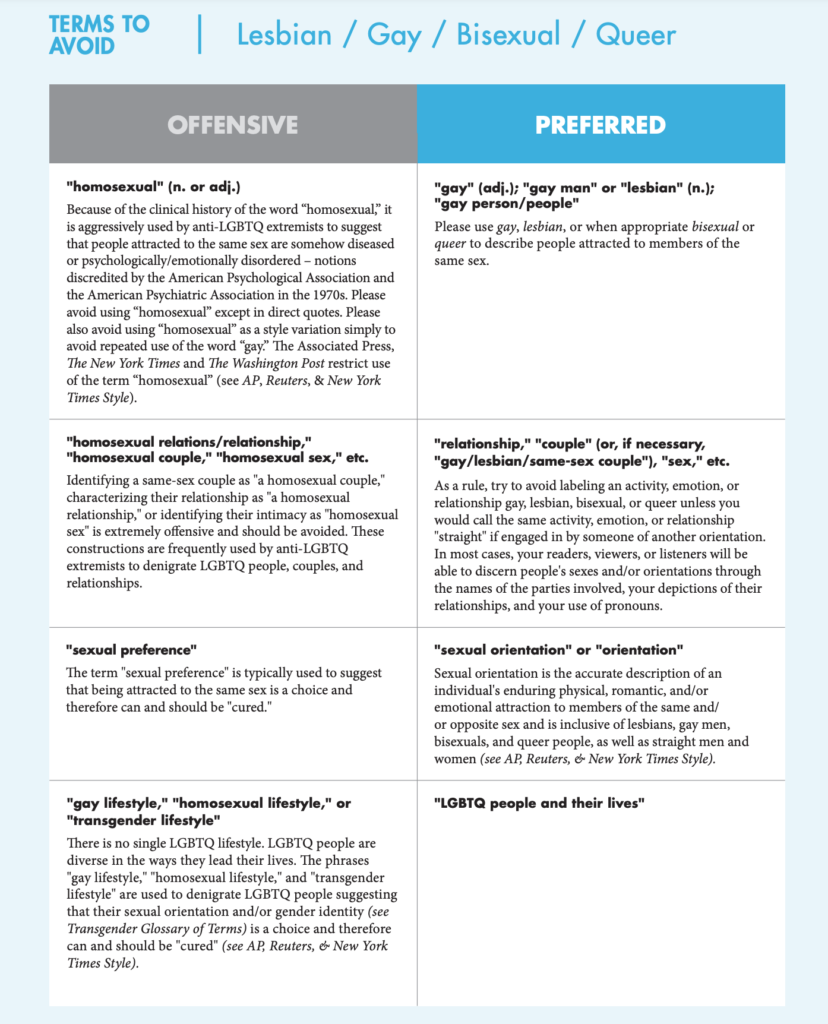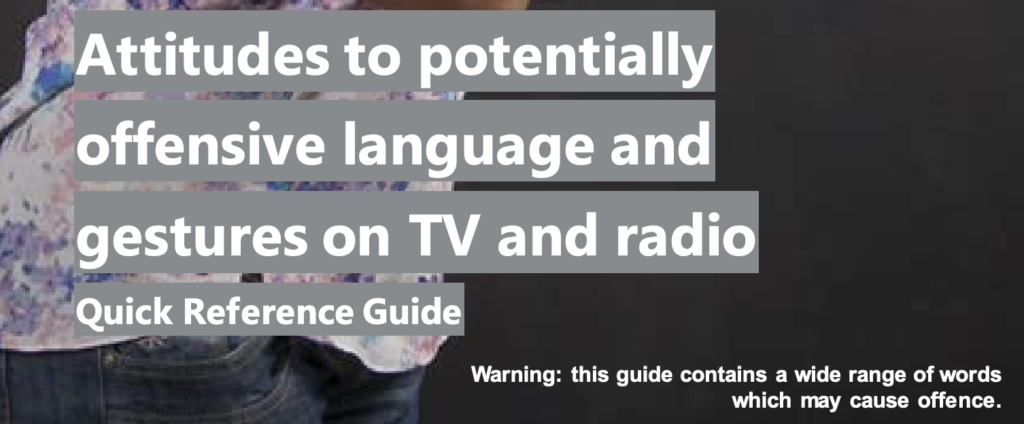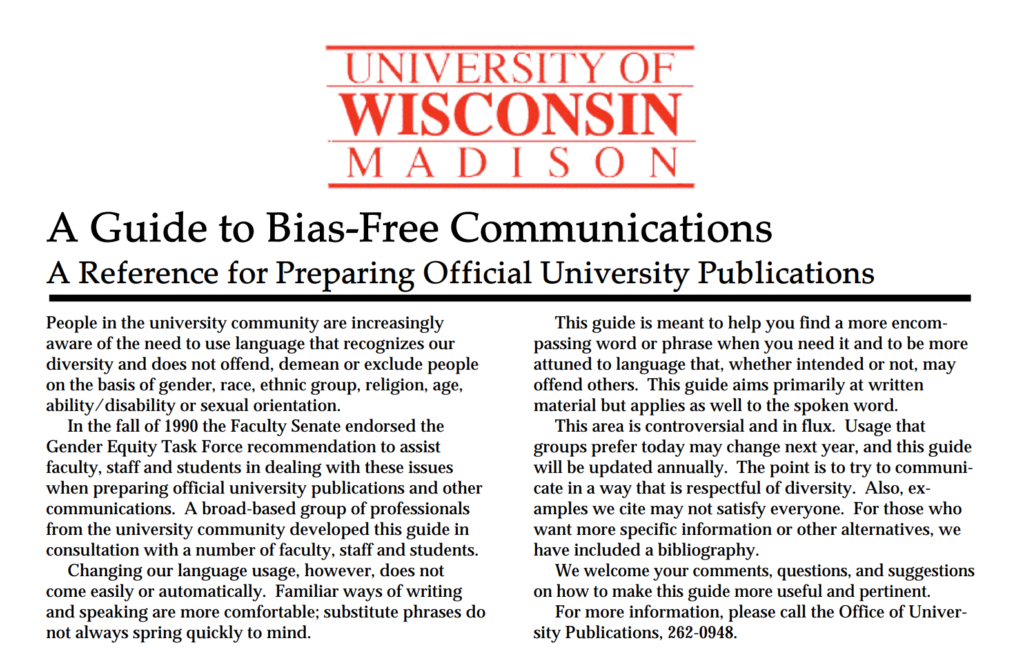- Innovative Resume Ideas to Help You Stand Out - May 8, 2025
- How to Create an ATS Career Page That Converts: Tips & Tools - April 29, 2025
- 5 Helpful Examples of a SHRM Job Description Template - March 4, 2025
A bias free language guide is an essential HR tool, especially if your goal is to create a more diverse and inclusive workplace. According to McKinsey & Co., more diverse companies are likely to outperform their less inclusive counterparts financially.
When searching for a bias-free language guide, comprehensiveness is key. A broader database, or a mix of different guides, helps you pave the way for effective communication across all types of HR scenarios. This way, you can reach candidates from all backgrounds without the risk of offending or excluding anyone based on their race, gender, age, disability, sexual orientation, and more.
What Is Bias Free Language?
Bias-free language refers to non-discriminatory language. You may, for example, swap out the term “spokesman” (a male-centric term) for “spokesperson” in an organizational context. In many instances, individuals face the challenge of substituting discriminatory terms with suitable neutral alternatives. A bias-free language guide functions as a quick reference in facilitating inclusive communication.
Here are 7 examples of bias free language guides you might find helpful:
Ongig Bias Free Language Guide — The Largest (and Ever-Expanding) Resource
Ongig specializes in helping you create D&I content for hiring. Ongig’s free Diversity Glossary features over 200 useful terms to spruce up your job descriptions for maximum impact across all audiences. For example, you can use more inclusive words to create an effective EEO statement that market your company to a broader talent pool.
And…The Ongig team continues to develop a one-stop source of bias-free language with 1,000+ flagged terms. Ongig’s bias-free language guide (built-into Text Analyzer— a paid SaaS solution for enterprises wanting to eliminate bias) ensures your job postings remain inclusive and consistent.
If you use “exclusionary words” in your job postings, Text Analyzer flags them, gives you a pop-up explaining why it might be excluding certain candidates, and offers inclusive replacements:
APA Bias Free Language Guide — The Foremost Authority
The APA (American Psychological Association) bias-free language guide emphasizes the importance of respect and inclusivity in every communication. APA’s bias free language guide spans various categories ranging from gender to historical context, age, and ethnic identity:
APA compiled the terms through an expert committee of bias-free language experts, creating a handy reference list to suit most communications. The association covers the subject of non-bias language in detail in Chapter 5 of the Publication Manual, the official source of the APA style.
Unique highlights:
- Socioeconomic Status (SE) – provides guidelines for writing about SES in a bias-free manner. It emphasizes using terms like “low-income” or “economically disadvantaged” instead of pejorative labels. It advises on avoiding assumptions and encourages the use of person-first language. Also it suggests considering the broader social and economic factors affecting individuals.
- Intersectionality – offers guidelines for writing about intersectionality, focusing on avoiding bias. It defines intersectionality as the complex, cumulative way different forms of discrimination (such as racism, sexism, and classism) combine, overlap, and intersect, particularly in the experiences of marginalized individuals or groups of people. This section gives tips for acknowledging and addressing these overlapping identities and encourages thoughtful, inclusive, and precise language in scholarly writing.
Brandeis “Oppressive Language List” — The Student-Led Initiative
Brandeis University’s Prevention, Advocacy and Resource Center (PARC) provides a list compiled by student staff impacted by violence. The team created a bias-free language guide that focuses on removing hurtful or potentially offensive words/terms.
PARC’s list establishes identity-first and person-first language that eliminates labeling practices, limiting progress and expression in individuals. Similarly, the list outlines the subtle identity-based slurs that might ostracize individuals or groups through stereotyping.
This inclusive language guide made news more than once in 2021, for being “too woke”. The New York Post reported that US Rep. Elise Stefanik, a Republican of New York, called the list:
“an all-out assault on our First Amendment” and an example of “the Far-Left cancel culture happening in our schools”
Brandeis University made a statement of their own, saying:
“These students have noted that many people who have experienced violence may be further harmed by the language others use in speaking with them, and they wished to educate others who want to understand the background of some terms, and to suggest more neutral language that can be used,”…”The list is in no way an accounting of terms that Brandeis students, faculty or staff are prohibited from using.”
source: Patch
Other bias-free reference lists have also led to disputes among communities (e.g., the University of New Hampshire bias-free language guide).
CSU Inclusive Language Guide
Colorado State’s inclusive language guide was created in 2019 by the Inclusive Communications Committee. The CSU inclusive language guide is not “official policy or required practice” but is meant to serve as a guide on phrases to avoid that are not inclusive (and suggestions for replacements).
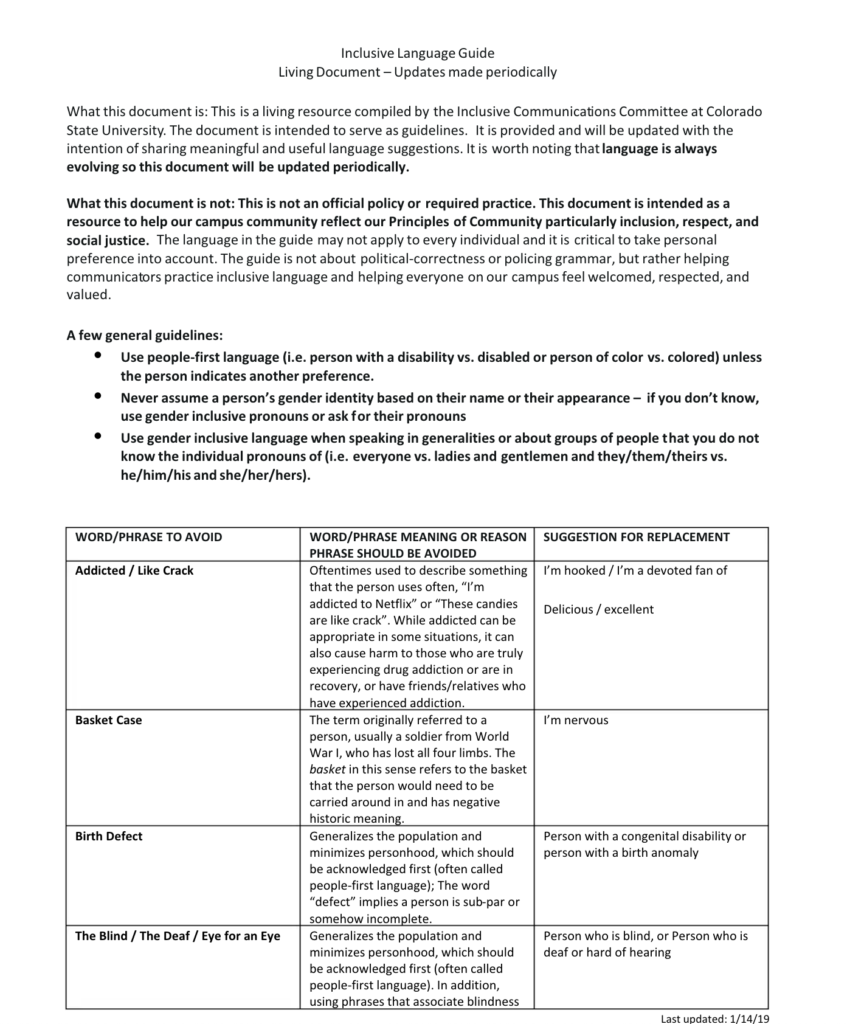
18F — The Governmental Bias Free Language Guide
18F is a governmental agency dedicated to improving user experiences across all communication channels. The 18F bias free language guide includes sections on age, disability, gender, and ethnicity. Through this comprehensive reference list, you can prepare gender-fair writing and promote positive connections with all readers.
And…18F identifies various biases connected with user experiences. These include research bias, where organizations assume their research covers every possible ground, or interviewer bias that drives one-sided sessions. These references can help your HR team create inclusive content catered to a broader community.
GLAAD — Bias Free Language for the LGBTQ+ Community
GLAAD was formed in 1985 in response to a defamatory article by the New York Post covering the subject of HIV and AIDS. The organization remains a leading force in navigating cultural change, providing bias free language references for modern communicators. The GLAAD bias free language guide offers an all-inclusive glossary for terms used in the LGBTQ community for non-discriminatory and accurate content.
The guide includes terms to avoid and preferred terms like the examples here:
Ofcom — A Media-based Bias Free Language Guide
Ofcom (Office of Communications) is the government-approved regulatory body for broadcasting and telecommunications with the UK. The body’s official bias free language guide documents various discriminatory (targeted language) and non-discriminatory terms and acceptable alternatives.
The official Ofcom Quick guide contains word entries from data collection and extensive research involving 200+ participants. It’s worth noting that the reference list comprises terms mainly catered to a UK audience.
University of Wisconsin — Bias Free Language Guide
University of Wisconsin’s Gender Equity Task Force convened in 1990 to create a bias free language reference guide in preparing official publications for diverse communities. The comprehensive list includes key terms for gender, age, race and ethnicity, disabilities, and sexual orientation.
The university’s educators note that it’s challenging to seek word substitutes. The guide assists staff and students with creating inclusive content. The university continues to amend and update the guide according to modern times and openly welcomes contributors to the ongoing initiative.
University of New Hampshire (UNH) – Inclusive Language Guide
The UNH Inclusive Language Guide discusses how the words and phrases we use daily can reflect and influence the way we see ourselves and others. It focuses on the importance of using language that does not stereotype, exclude or demean individuals based on their characteristics.
The guide starts by introducing microaggression, a subtle but stereotypical comment or assumption about a person’s identity, background, ethnicity, or disability. It tackles different forms of microaggression, such as micro-assault, micro-insult, and micro-invalidation.
Examples:
Micro-assault: “Why do you need a wheelchair? I saw you walk… You can walk, right?” to a person who is using a mobile chair for long-distance travel.
Micro-insult: A person exhibits a stubborn, begrudging attitude that they will accommodate an accessibility request. The verbalization is appropriate, but the tone seems insulting.
Micro-invalidation: “You have a learning disability? How can you be a lawyer?” to a person with a learning disability.
Other Highlights:
- Using person-first language means centering the person rather than their disability or condition. For example, instead of saying “a disabled person,” we could say “a person with a disability.”
- Acknowledging individuals’ right to choose how they want to be identified means using someone’s preferred pronouns and avoiding labels that they don’t find respectful. For example, if someone tells you that they use they/them pronouns instead of the singular pronoun he/she, you should respect their preference and use those pronouns when referring to them.
- Use neutral language when referring to people’s marital status, age, or other personal characteristics.
Examples:
Age: Use “older adults” instead of “the elderly.”
Economic Status: Use “person experiencing poverty” rather than “poor person.”
- Awareness of your own biases and how they might influence your language use.
University of Washington (UW) – Bias-Free Language Guide
The University of Washington’s IT Department offers a Bias – Free Language Guide to promote inclusive language within its technological content and communication. It gives practical advice and resources to help IT professionals achieve this goal. It also educates on problematic words and phrases and suggestions for alternatives.
Highlights:
- Using gender-neutral language in all communications like job postings and other areas, suggesting alternatives like “they/them” pronouns, and opting for phrasing like “users” instead of “guys.”
- Eliminating stereotypes by discouraging words and phrases that make assumptions about people based on race, ethnicity, nationality, religion, disability, or age.
Example:
Instead of saying “confined to a wheelchair,” use “uses a wheelchair” to emphasize the person’s agency.
- Observing cultural sensitivity by being mindful of the potential for specific terms to have different meanings in various cultures. It educates people to avoid expressions that might be insensitive or offensive in particular contexts.
Example:
Instead of ‘tribal knowledge,’ use ‘institutional knowledge’ or ‘organizational knowledge.’
Why it’s problematic: In a Western context, the word “tribal” often implies savage and further perpetuates stereotypes of primitiveness, lack of culture, and uneducated. Calling people “tribal” is equivalent to a racial stereotype. Institutional knowledge is more accurate when referring to a long-time employee’s understanding of processes and operations.
By following the guide’s principles, individuals can contribute to fostering a diverse and welcoming community where everyone feels valued and respected.
American Cancer Society – Inclusive Language and Writing Guide
The Inclusive Language and Writing Guide by the American Cancer Society emphasizes respectful and inclusive communication that represents the communities’ perspectives and experiences – American Cancer Society (ACS) and American Cancer Society Cancer Action.
Network SM (ACS CAN) staff, volunteers, people with cancer, their caregivers, and the cancer communities. It provides detailed guidance on language use related to race, ethnicity, gender identity, sexual orientation, and disability status.
Highlights:
- Covers inclusive writing and communication – using plain language as much as possible (avoiding jargon, minimizing abbreviations and spelling acronyms), using active voice, and writing for your audience (knowing the expertise level, interest level, and comfort level of your audience group
- Underscores the importance of using person-centered language, focusing on the individual’s dignity, strength, and uniqueness rather than their disease or condition.
Example:
Instead of labeling someone as a “cancer patient,” refer to them as a “person with cancer.”
- Advises against using outdated, stigmatizing, or stereotypical words and terms. The goal is to communicate without reinforcing negative stereotypes or stigmatizing individuals based on their health conditions or life circumstances.
Example: Instead of labeling someone as a “victim” or “suffering from cancer,” refer to them as “cancer survivor” or “person being treated for cancer.”
To ensure accurate representation, community members were engaged to create the materials in this comprehensive and unbiased language guide. Individuals from communities were invited to give input and act as subject matter experts, so the content genuinely reflects the experiences and preferences of those communities.
These points collectively aim to promote respectful, inclusive, and effective communication that honors the individuality and dignity of all people, particularly those affected by health disparities.
Racial Equity Tools Glossary
The Racial Equity Tools Glossary is a comprehensive resource that promotes shared understanding and improves dialogue on racial equity issues. It highlights the evolution of language related to racism by emphasizing the importance of context and the different meanings words can have for other people.
The glossary covers various terms, from “ableism” to “white supremacy,” providing detailed definitions and sources for each. It aims to support anti-racism initiatives by clarifying terminology and encouraging thoughtful discussions about race, power, and privilege.
Gender
When we talk about using bias-free language, gender is an essential aspect to consider. It’s all about making sure our words respect and include everyone, regardless of their gender identity. Let’s explore some guidelines to help you navigate this topic smoothly.
Firstlyf, let’s talk about using specific terms instead of broad categories. Instead of saying “men” or “women,” try to use more specific designations like “transgender women,” “cisgender women,” “gay men,” or “lesbian women.” So, this shows respect for the diversity within these groups.
For example, instead of saying “elderly people,” which can be seen as somewhat negative, try using “older adults” or “senior citizens.” It’s a simple rule that can make a big difference in how we talk about and perceive others.
In addition, avoid using terms that might reinforce stereotypes or biases. For instance, instead of saying things like “Asian Americans,” you could use more specific terms like “Chinese Americans” or “African Americans.” So, this acknowledges the cultural diversity within these groups.
When discussing gender, it’s also crucial to use gender-neutral language whenever possible. This means using terms like “they” or “their” instead of assuming someone’s gender with pronouns like “he” or “she.” It’s a small change that can make a big impact on inclusivity.
Additionally, it’s important to remember that language changes over time. So, staying updated on bias-free language guidelines is key. Organizations like APA’s Bias-Free Language Committees offer valuable resources and recommendations. They provide specific examples and general principles to guide us in our use of inclusive language.
Ultimately, being mindful of the words we use when discussing gender, along with other aspects of identity, helps create a more inclusive environment for everyone.
Race and Ethnicity
It’s crucial to use specific terms rather than broad categories when referring to racial and ethnic groups. Instead of using terms like “Black” or “White,” try using more specific designations. This acknowledges the individuality within these groups and avoids reinforcing stereotypes.
In addition, another important aspect is to avoid using labels that might unintentionally perpetuate stereotypes or biases. So, instead of using terms like “racial minorities,” which can be vague and potentially stigmatizing, opt for more descriptive language like “underrepresented racial groups” or “people of color.”
Also, when discussing race and ethnicity, be mindful of unconscious biases that may influence our language choices. This means being aware of our own assumptions and using language that reflects a genuine understanding and respect for diverse backgrounds.
Overall, using bias-free language in discussions about race and ethnicity helps create a more inclusive environment for everyone. So, follow these guidelines and be mindful of your language choices, to help foster understanding and respect across diverse communities.
Disability
When it comes to using bias-free language, it’s crucial to consider how we talk about disability. Our words can have a big impact on how people with disabilities are perceived and treated.
Let’s talk about using person-first language. This means emphasizing the person first, rather than their disability. For example, instead of saying “disabled person,” it’s better to say “person with a disability.” So, this puts the focus on the individual rather than their disability.
It’s also important to avoid using labels that may be seen as derogatory or stigmatizing. So, terms like “special needs” or “handicapped” can be hurtful to some people with disabilities. Instead, opt for more neutral and respectful language like “individuals with disabilities” or “people with special requirements.”
In addition, when discussing disability, acknowledge the diversity within the disability community. So, not all disabilities are visible, and people with disabilities come from all walks of life. Therefore, using terms like “intellectual disability” or “physical disability” helps recognize the wide range of experiences and challenges faced by individuals.
Additionally, be mindful of using language that implies limitations or deficits. So, instead of focusing on what someone can’t do, try to emphasize their abilities and strengths. For example, instead of saying “wheelchair-bound,” you could say “uses a wheelchair.”
Lastly, always prioritize the individual’s preferences when referring to their disability. So, some people may prefer identity-first language, such as “autistic person,” while others prefer person-first language, like “person with autism.” Therefore, you must respect their choice and use the language that they prefer.
General Guidelines for Bias Free Language
Describe at the appropriate level of specificity
Finding the right level of specificity is about being detailed enough to be respectful and inclusive while avoiding stereotypes or assumptions.
Firstly, avoid using overly general terms or broad categories when describing people. Instead of lumping everyone together, try to be more specific. For example, instead of saying “ethnic groups,” you could specify which group you’re referring to, such as “Native Americans” or “Chinese Americans.”
Similarly, when discussing gender identity or sexual orientation, using specific designations like “transgender women” or “gay men” is more respectful than using broad terms like “LGBTQ+” or “sexual preference.” This shows that you recognize the diversity within these communities.
On the other hand, it’s also essential not to get too bogged down in overly specific details when they’re not relevant. So, if you’re discussing a topic where age isn’t a crucial factor, there’s no need to mention “exact ages” or “individual characteristics of age.” Keep it relevant and focused on the topic at hand.
In addition, when describing people with disabilities, use language that respects their dignity and autonomy. Avoid using labels like “blind person” or “autistic person” as sole descriptors. Instead, use person-first language like “person who is blind” or “person with autism” to emphasize their humanity first.
Overall, the key is to be thoughtful and considerate in your language choices. So, aim to strike a balance between being specific enough to be inclusive and respectful. Also, avoid unnecessary details or assumptions.
Be sensitive to labels
Recognize that labels can sometimes carry negative connotations or reinforce stereotypes. So, instead of using labels like “elderly people” or “older person,” which can imply frailty or dependency, opt for more neutral terms like “older adults” or “senior citizens.”
Similarly, when referring to people with disabilities, avoid using labels that reduce individuals to their disability. Instead of saying “blind person” or “autistic person,” use person-first language like “person who is blind” or “person with autism.” So, this emphasizes their humanity first and foremost.
Also, when discussing racial or ethnic identity, use labels that are respectful and accurate. So, avoid using outdated or offensive terms like “colored” or “negro.” Instead, use terms like “African American” or “Latinx” that reflect the preferences of the individuals or groups you’re referring to.
Take the time to understand the preferences of the individuals or groups you’re referring to, and choose language that is respectful, accurate, and inclusive. By being sensitive to labels, we can create a more respectful and inclusive environment for everyone.
Why I Wrote This?
Ongig’s mission is to help you discover the most effective way of attracting candidates through bias free language in JDs (and other hiring content). Please request a demo to learn more about how the Text Analyzer software can support your D&I goals.
Shout-Outs:
- Diversity wins: How inclusion matters (by McKinsey & Company)
- The Harmful Effects of Labeling People (Ourselves and Others), Plus Finding Hope For the Future (by Leigh Aguirre)
- GLAAD Media Essentials Guide (by GLAAD)
- A Guide to Bias-Free Communications (by The University of Wisconsin Madison)
- Bias-Free Language (by APA Style)
- Suggested Language List (by Brandeis Prevention, Advocacy & Resource Center)
- Attitudes to potentially offensive language and gestures on TV and radio Quick Reference Guide (by OFcom and Ipsos MORI)
- Inclusive language guide (by 18F)
- GLAAD’s Media Reference Guide
- Brandeis ‘Potentially Oppressive Language’ List Raises Eyebrows (by Jenna Fisher)
- Brandeis warns students not to say ‘picnic,’ ‘rule of thumb,’ calling words ‘oppressive’ (by Bernadette Hogan, Carl Campanile and Bruce Golding)
- The story behind the University of New Hampshire’s ‘Bias-Free Language Guide’ (by Janell Ross)
